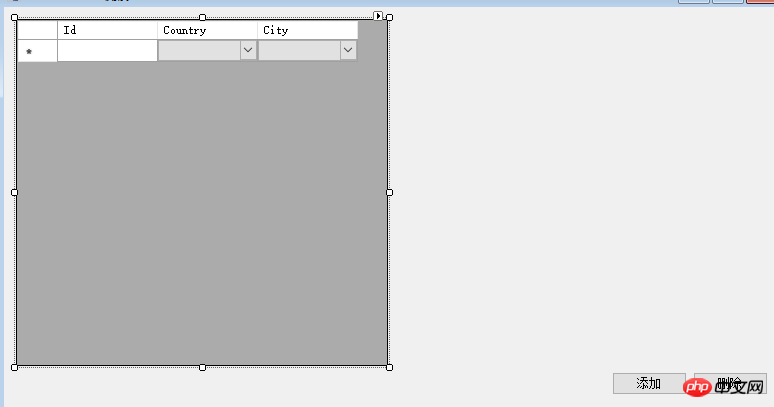
1, erstellen Sie eine Winform-Formularanwendung
2, ziehen Sie das DataGridView-Steuerelement in die Schnittstelle 
3, fügen Sie die entsprechenden Spalten wie gezeigt hinzu: 

4, beginnen Sie mit dem Schreiben des folgenden Codes:
private DataTable CountryDt = new DataTable();
private DataTable CityDt = new DataTable();
public Main( )
InitializeComponent() jing“, „CN|2|Tianjin“, „CN |3|Shanxi“, „JP|4|Osaka“, „JP|5 |Yokohama“, „JP|6|Nagoya“, „JP|7|Kobe“, „US|8|New York“
, , , , , „US|9|Los Angeles“, „US|10|Chicago“, „US|11|Houston“, „US|12|Philadelphia“, „US|13|San Francisco“};
CityDt.Columns.Add("cityName");
CityDt.Columns.Add("Pid");
for (int i = 0; i < columns.Length;
🎜> 🎜> private void initcountrydt ()
String [] Länder = {"cn | China", "JP | Japan", "US | USA"};
CountryDt. Columns.Add("countryCode");
CountryDt.Columns.Add("countryName");
for (int i = 0; i < states.Length; i++)
{
var newRow = CountryDt.NewR ow();
newRow["countryCode"] = states[i].Split('|')[0];
newRow["countryName"] = states[i].Split ('|')[1];
CountryDt.Rows.Add(newRow);
}
}
dt.Columns > .Rows.add (newrow);
}
datagridView1.dataSource = dt; 🎜>
var newRow = dt.NewRow();
newRow["Id"] = dt.Rows.Count + 1;
dt.Rows.Add(newRow);
for (int i = 0; i < dt.Rows.Count; i++)
{
var countryCell = new DataGridViewComboBoxCell();
CountryCell.DataSource = 🎜> countryCell. ValueMember = "countryCode";
countryCell.DisplayMember = "countryName";
dataGridView1.Rows[i].Cells["countryCode"] = countryCell;
}
}
{
var dt = this.dataGridView1.DataSource as DataTable;
if. (dataGridView1.Columns[e.Colum nIndex].Name == nameof(CountryCode))
{
var countryCode = dataGridView1.Rows[e.RowIndex].Cells[e.ColumnIndex].Value;
var drs = CityDt.Select("Pid='" + countryCode + "'") ;
var newCityDt = new DataTable();
newCityDt.Columns.Add("cityCode");
newCityDt.Columns.Add("cityName");
newCityDt.Columns.Add(" Pid");
foreach (DataRow row in drs)
var newRow = newCityDt.NewRow();
newRow["cityCode"] = row["cityCode"];
newRow["cityName"] = row["cityName"];
newCityDt.Rows.Add(newRow);
}
var cityCell = new DataGridViewComboBoxCell();
cityCell.DataSource = newCityDt;
cityCell.DisplayMember = "cityName";
dataGridView1.Rows[e .RowIndex].Cells["CityCode"] = cityCell;
GridView1.DataSource als DataTable;
for (int i = 0; ich < vdt.Rows.Count; i++)
{
var cell = new DataGridViewComboBoxCell()
{
. ValueMember = "countryCode",
DataSource = CountryDt
};
dataGridView1.Rows[i].Cells["CountryCode"] = cell;
if (i % 2 == 0)
{
dataGridView1.Rows[ i].Cells["CountryCode" ].Value = "JP";
dataGridView1.Rows[i].Cells["CityCode"].Value = new Random().Next(4, 7);
}
//else {
// dataGridView1.Rows[i].Cells["CountryCode"].Value = "CN";
//}
if (i % 5 == 0)
. {
dataGridView1.Rows[i].Cells["CountryCode"].Value = "CN";
dataGridView1.Rows[i].Cells["CityCode"].Value = new Random().Next(1, 3) ;
}
if (i % 9 == 0)
{
dataGridView1.Rows[i].Cells[" CountryCode"].Value = "US";
dataGridView1.Rows [i].Cells["CityCode"].Value = new Random().Next(8, 13);
}
}
EventArgs e)
var selected = dataGridView1.SelectedRows;
if (selected.Count > 0)
{
for (var i = 0; i < selected.Count; i++)
{
var row = selected[i];
dt.Rows.RemoveAt(row .Index);
}
}
}
Das obige ist der detaillierte Inhalt vonWie implementiert man das Hinzufügen, Löschen und Ändern von DataGridView?. Für weitere Informationen folgen Sie bitte anderen verwandten Artikeln auf der PHP chinesischen Website!
 Array-Initialisierungsmethode
Array-Initialisierungsmethode
 So lösen Sie das Problem, dass CSS nicht geladen werden kann
So lösen Sie das Problem, dass CSS nicht geladen werden kann
 Was tun, wenn CSS nicht geladen werden kann?
Was tun, wenn CSS nicht geladen werden kann?
 Die Initialisierungsroutine der Dynamic Link Library ist fehlgeschlagen
Die Initialisierungsroutine der Dynamic Link Library ist fehlgeschlagen
 So binden Sie Daten in einer Dropdown-Liste
So binden Sie Daten in einer Dropdown-Liste
 Was tun, wenn das Laden der DLL fehlschlägt?
Was tun, wenn das Laden der DLL fehlschlägt?
 Das heißt, die Verknüpfung kann nicht gelöscht werden
Das heißt, die Verknüpfung kann nicht gelöscht werden
 So lösen Sie das Problem, dass die IE-Verknüpfung nicht gelöscht werden kann
So lösen Sie das Problem, dass die IE-Verknüpfung nicht gelöscht werden kann




